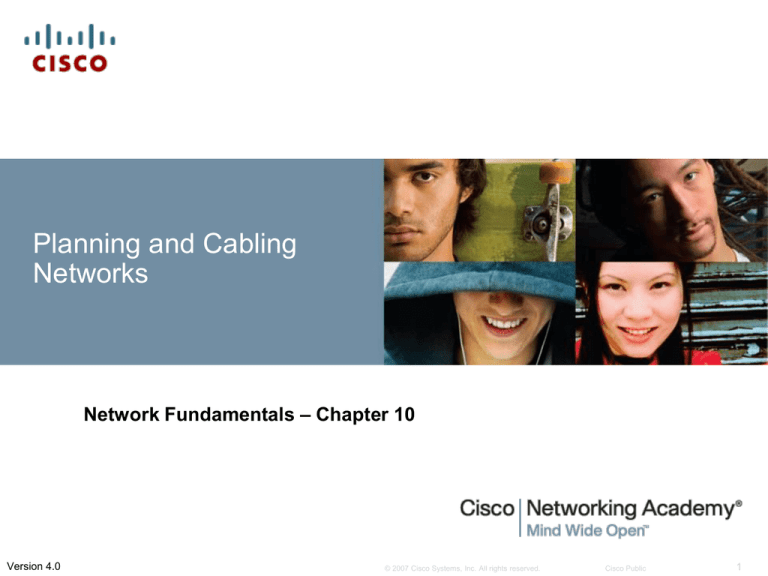
Planning and Cabling
Networks
Network Fundamentals – Chapter 10
Version 4.0
© 2007 Cisco Systems, Inc. All rights reserved.
Cisco Public
1
Objectives
Identify the basic network media required to make a LAN
connection.
Identify the types of connections for intermediate and end device
connections in a LAN.
– Identify the pin out configurations for straight-through and crossover
cables.
- Identify the different cabling types, standards and ports used for WAN
connections.
- Define the role of device management connections when using Cisco
equipment.
Design an addressing scheme for an inter-network and assign
ranges for hosts, network devices and the router interface.
Compare and contrast the importance of network designs.
© 2007 Cisco Systems, Inc. All rights reserved.
Cisco Public
2
Basic Network Media Required to Make a LAN
Connection
Select the appropriate hardware, including the cabling,
to install several computers together in a LAN
© 2007 Cisco Systems, Inc. All rights reserved.
Cisco Public
3
Basic Network Media Required to Make a LAN
Connection
To identify some key aspects of the devices they will be
employing in a LAN
© 2007 Cisco Systems, Inc. All rights reserved.
Cisco Public
4
Basic Network Media Required to Make a LAN
Connection
Connect two computers with a switch
© 2007 Cisco Systems, Inc. All rights reserved.
Cisco Public
5
Types of Connections in a LAN
Given a specific network connection, identify the type of
cable required to make the connection
© 2007 Cisco Systems, Inc. All rights reserved.
Cisco Public
6
Types of Connections in a LAN
Identify the correct cable to use in connecting
intermediate and end devices in a LAN
© 2007 Cisco Systems, Inc. All rights reserved.
Cisco Public
7
Types of Connections in a LAN
Identify the pinout of the straight-through and crossover cables
© 2007 Cisco Systems, Inc. All rights reserved.
Cisco Public
8
Types of Connections in a LAN
Recognize that a different class of cables is used to
connect WANs, and that the cables, standards and
ports are different than those in use by LANs
© 2007 Cisco Systems, Inc. All rights reserved.
Cisco Public
9
Types of Connections in a LAN
Define the role of device management connections
when using Cisco equipment
© 2007 Cisco Systems, Inc. All rights reserved.
Cisco Public
10
Design an Addressing Scheme for an Internetwork
Design an address scheme for an internetwork and
assign ranges for hosts, network devices and the router
interface
© 2007 Cisco Systems, Inc. All rights reserved.
Cisco Public
11
Design an Addressing Scheme for an Internetwork
Calculate the address ranges for sub networks
© 2007 Cisco Systems, Inc. All rights reserved.
Cisco Public
12
Importance of Network Designs
Given a network scenario, develop an appropriate
networking scheme
© 2007 Cisco Systems, Inc. All rights reserved.
Cisco Public
13
Importance of Network Designs
Determine the total number of hosts in a network,
accounting for present and future requirements
© 2007 Cisco Systems, Inc. All rights reserved.
Cisco Public
14
Importance of Network Designs
Given a network requirement, determine the optimum
number of sub networks in the larger internetwork
© 2007 Cisco Systems, Inc. All rights reserved.
Cisco Public
15
Importance of Network Designs
Describe how to count the segments between router
interfaces
© 2007 Cisco Systems, Inc. All rights reserved.
Cisco Public
16
Summary
© 2007 Cisco Systems, Inc. All rights reserved.
Cisco Public
17
© 2007 Cisco Systems, Inc. All rights reserved.
Cisco Public
18




